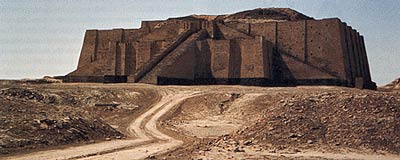

Introduction to Archaeology and Palaeoanthropology:
Humanity's Journeys
Dr. Kathryn Denning
Anth 2140, Sept 2005 - Apr 2006
Ziggurat of Ur.
31 Jan 2006... Hi!
Plan for the day
1 Course business/ announcements...
2 From the Great Diaspora to The First Civilizations, via Farming
Reading and Assignments
Museum Assignment hand out. (Link: assignment details will also be posted here.) It is due March 1st.
n.b. I will stop by the museum in the late afternoon/early evening (say, 5-7) on the next couple of Fridays. Do ask me questions then, if you wish.
Tomorrow in tutorial: Quiz #4. Review.
Schedule
For today, Jan 31: Fagan Ch 12, 315-344. The First Civilizations.
Feb 7, 8 NO CLASS NEXT WEEK - no lecture, no tutorial - go to the museum.
Feb 14, 15: Reading Week
Feb 21 A short online reading has been added for the week after Reading Week: Fagan Ch 13, Early Asian Civilizations AND ONLINE: Jared Diamond: Why Did Human History Unfold Differently On Different Continents For The Last 13,000 Years? /www.edge.org/3rd_culture/diamond/diamond_p1.html
The major developments in world prehistory
- origins of humankind 2.5 mya
- evolution of archaic humans like Homo erectus and then,anatomically modern humans (H. sapiens sapiens) 1.9 mya to 15 000 years ago
- the spread of anatomically modern humans throughout the Old World and the Americas, a process ending 15 000 years ago
- origins of complex forager societies, of agriculture and animal domestication (food production), after about 11 000 years ago, the spread of agriculture
- the development of greater cultural complexity, including civilizations (urbanized, literate, state-organized) around 3100 BC in western Asia, and then elsewhere
"The Great Diaspora"
- the expression Fagan uses for the spread of modern H. sapiens sapiens throughout the world.
- As you know, Hss replaced Neanderthal groups by around 33 000 BC (and this has traditionally been assumed to mean that we were then the last hominids left, but we now know that H.floresiensis existed elsewhere).
- The Late Ice Age environment was very diverse, and the Cro-Magnon adaptation to it was flexible. Societies grew more complex, and so did their technology.
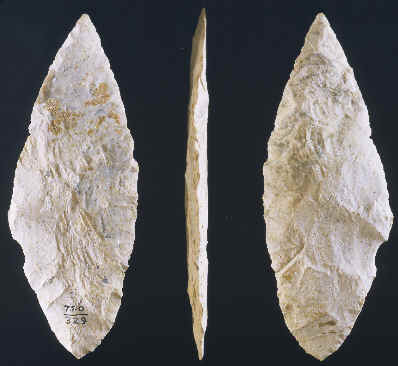
- e.g. Atlatl - great for hunting prey from a greater distance: Used throughout the world http://www.royalbcmuseum.bc.ca/hhistory/atlatl/atlatl.html
- n.b. We name archaeological cultures according to what their 'stuff' looks like. Different styles of stone points, for example, get different names. We can be pretty sure that the 'Magdalenians' didn't call themselves that... and they may not have even recognized themselves as a single group of people...
- amazing art starting around 30 000 BP, e.g. Lascaux


- we're not sure about the meaning of the art (engraving, sculpture, painting, adornment of portable objects) - maybe 'religious' in the sense of magic, shamanism, initiation ceremonies
- western Siberia was settled as early as 28 000 BC, but the eastern part (closest to the New World) appears to have nothing until the very late Ice Age, 13 000 BC (interesting implications for settlement of New World)
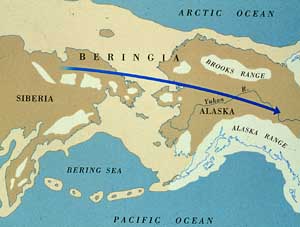 - Siberia
was at least one of the stepping off points for the settlement of the
Americas... via the Bering Land Bridge... by 15 000 BC or thereabouts.... but
there are also some sites much further south (South America) which may be
EARLIER... our understanding of the peopling of the Americas is far from
complete.
- Siberia
was at least one of the stepping off points for the settlement of the
Americas... via the Bering Land Bridge... by 15 000 BC or thereabouts.... but
there are also some sites much further south (South America) which may be
EARLIER... our understanding of the peopling of the Americas is far from
complete.
Modern Humans Settle The World
Remember, human species had lived throughout the Old World previously.... still some debate about multiregional vs. 'Out of Africa' hypotheses explaining the worldwide distribution of Homo sapiens sapiens. But we are certain that currently we are all one species, and that differences between us are trivial.
By 50 000 ybp, modern H.s.s. were living throughout the Old World (and H.s.n. and H.f. were in a few places).
The period about 50 000 to 10 000 ybp
- foraging/collecting/hunting
- explosion of art, rapid development of technology
- 'territories' emerge - reinhabiting sites
- slow expansion of population size
Settling of the Americas - highly contested
DATA include skeletal remains (including teeth), artifacts, habitation and burial sites, language families
DIFFICULTIES include poor preservation, ambiguous remains, and submersion under water of relevant locations
.... Americas inhabited definitely by 15 000 BP but possibly much earlier than that
.... multiple waves of migration are certain
.... stay tuned for more research
.... remember that the debate is deeply, deeply political
Nice Languages of the Americas animation: http://www.msnbc.com/news/144348.asp?cp1=1
The Importance of Farming
- farming developed in multiple locations more or less independently, starting around 10 000 bp
- development of farming/food production/domestication... has interesting and significant corollaries:
- sedentism
- storage/accumulation of wealth
- population growth
- intensification.... ecological impact
- social stratification/increasing social complexity
- increased territoriality
- increased interdependence for long-range resources
n.b. Most foods we use today were domesticated in antiquity. (Not everything is domesticable.)
THE TRAJECTORY OF FARMING
If that was the Neolithic... we are now in the "Neocaloric" (Ernest Schusky)
“For several million years, humans have followed the simple, logical principle of never expending more calories on food production than they received in return. The principle if most obvious in food collecting, but it is just as necessary in food production. It appears that as a general rule, food production gave greater returns than food collecting, but if the only needs were food and shelter, then the increased returns from agriculture were unnecessary. That is, greater returns did not necessarily make life any better nor even insure more reliability in the food supply." Schusky, Culture and Agriculture, 1989:103
So why did agriculture start, way back when??
Recent research has suggested that it was due to different factors in different places... but in some, it was due to competitive feasting and status.... not the need for more food for survival.
The characteristics of agriculture now...
A vast increase in the nonhuman energy (fertilizers, pesticides, herbicides, machinery and fuel) devoted to food production (crops and livestock). Concomitant increase in production per human labour hour... because machines are doing the work... but that energy isn't free, it just comes from somewhere else.
So as we look back at the origins of agriculture and the earliest civilizations, we need to bear in mind that the labour was human and animal, and that this is a major difference between the civilizations of yesteryear, and ours here today.
What are the big issues? What are the characteristics that tie all civilizations together? How are their trajectories similar? What can we learn from studying past civilizations?
An interesting argument made recently by Ronald Wright.
(Ronald Wright, A Short History of Progress, the 2004 Massey Lectures, http://www.cbc.ca/ideas/massey.html, also in book form.
Wright's lectures are structured around the age-old questions: Where do we come from? What are we? and Where are we going?
His second lecture, "The Great Experiment", starts with the sabre-toothed cat.
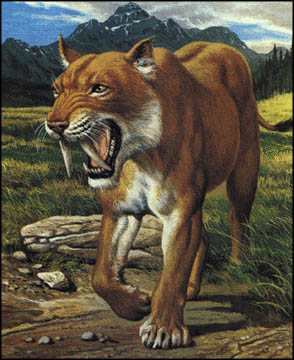
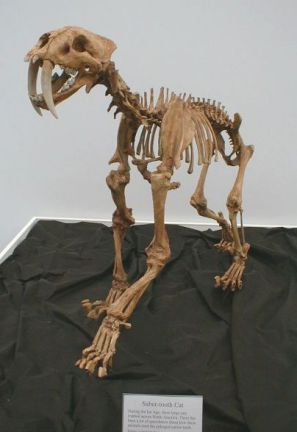

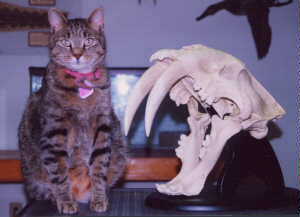
More on sabre-tooths: http://www.ucmp.berkeley.edu/mammal/carnivora/sabretooth.html http://www.bbc.co.uk/beasts/evidence/prog5/page2.shtml
The sabre-tooth cats, (e.g. Smilodon, but other species too... though not tigers) were once widespread throughout the Americas and Europe in the Pleistocene. They became extinct about 10 000 years ago. Smilodon was a highly specialized predator... and when its prey became extinct (due to climate change or perhaps human over-hunting), it did too. It was so specialized that it could not change strategies. Its teeth would be very effective for killing large animals and hunting in packs, but the Smilodon would have been bad at hunting smaller animals. It was itself large and probably not very fast, and broken teeth could mean death.
Wright argues that this is an example of a "progress trap" -- an adaptation that works very well for a while, but then becomes fatal to a species.
Human beings have become experimental creatures of our own making, through our cultural adaptations. As cultures become more elaborate, they can become more specialized.
Wright contends that farming is a "progress trap" -- of a different sort from nuclear weapons (a significant 'advance', since they could kill us all).
It's farming that has made our growth and increasing specialization possible.
Since the early 1900s, Earth's population has multiplied by a factor of 4. Our economy (use of Earth's resources/footprint) has multiplied by a factor of 40. It is time, Wright contends, to bring this experiment under rational control... for the first time. (Ecological footprint: http://www.earthday.net/goals/footprint.stm )
As Wright puts it, civilization doesn't run deep, but it runs wide. It's fairly new historically (consider that for a hundred thousand years, H. sapiens lived as hunter-gatherers in small groups). But it has been so successful as an adaptation that the population increase has been huge. More people have lived a civilized life than any other kind of life.
Civilized = large, complex, based on the domestication of plants, animals, and humans.
[Civilized does not mean morally superior; consider the many historical atrocities wrought by civilizations. Civilization may not always be very nice, but we are stuck with it now, and should do our best to ensure that this experiment works.]
Since culture has essentially forestalled natural selection, we are, Wright contends, running 21st century software on hardware that was last upgraded 50 000 years ago.
Landmarks in human "progress", according to Wright.
Fire - Homo erectus.
The perfection of hunting
- by H. sapiens sapiens, e.g. CroMagnon. After the Neanderthals were displaced/replaced, there was an incredible florescence of art, more specialized hunting weaponry, etc. This couldn't be the result of new brains, since some of those things had been present before, but on a smaller scale. It is more likely to be the result of leisure time.... because there was very abundant food, due to the refinement of hunting methods.
Ice Age extinctions: Upper Palaeo sites in Europe have included butchering sites with 1000 mammoths, or 100 000 horses. This suggests that some ancient hunter-gatherers were not the same as those today. Today, H-G peoples are wise stewards of their ecosystems, but in the past, we have evidence over and over again of probable over-hunting and undoubted extinction at the end of the Palaeolithic. (Megafauna in North America and Australia, too....) n.b. climate contributed too.
e.g. Moas hunted to extinction in New Zealand shortly after human arrival http://www.duke.edu/~mrd6/moa/

More on megafauna extinctions: http://darwin.bio.uci.edu/%7Esustain/bio65/lec03/b65lec03.htm
After the "all you can kill wildlife barbecue" and the extinctions, there came the end of the way of hunting. In Europe, the great cave art stops. The flint blades got smaller. There are other signs of stress and change. Etc.
As Wright puts it, these people had violated Rule 1 for any prudent parasite: Don't kill off your host. The perfection of hunting had been a "progress trap".
People were forced, in the Mesolithic, to broaden their food base. (I call it foraging in the back of the fridge.)
Then came the Neolithic Revolution/ Invention of Farming.
Wright contends that this was as important to human history as the invention of nuclear weapons.
- the food technology of antiquity sustains us today
- the crops of a dozen ancient peoples feed us all now
- not one new staple has been added since prehistory
but n.b. most people throughout most of time have lived on the edge of hunger, as many still do today. Wright says: We are stuck in another "progress trap".
The First Civilizations! Survey
Fagan Ch 12 is very clear on this topic, and
it's essential for you to know this chapter well before we go further in the
course.
Food production is key. It may have emerged for different reasons ( a need for surplus/luxury, e.g. competitive feasting, or maybe a need for food security/survival when population increased) ... but the general result is an increase in social complexity and an increase in landscape modification. In the past, labour was human and animal (not machine and chemical), and labour requirements were therefore vast.
"Civilizations"
- arose independently in multiple parts of the world (an astonishing fact in itself!) - Nile Valley, Meopotamia, Indus Valley, North China, Mesoamerica, Andean region. (Perhaps more complex societies yet to be discovered, but a full-blown civilization would be a big surprise.)
civiliations are state-organized societies (archaeological ones are pre-industrial, i.e. before fossil fuels)
They have:
- cities (pop of 5 000 or more; dense; centralized with division of labour, depend on hinterland for food, monumental architecture, centralized government)... you can have a state without a city, but not really a city without a state
- economies based on centralized accumulation of capital and social status through tribute and taxation
- advances towards formal record keeping, science, mathematics, and some form of written script
- monumental architecture and impressive public buildings
- some form of state religion, often with a deified ruler or ruling class
Earliest civilizations of Mesopotamia
Where?
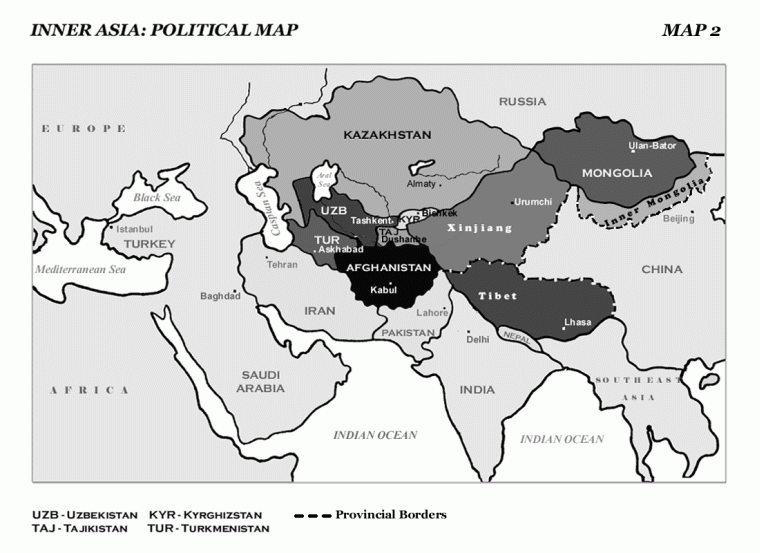

When?
Early farming villages, irrigation: 6500-4200 BCE
Uruk: 4200 - 3100 BCE
Early Dynastic (Sumerians, early Ur): 2900-2350 BCE
Akkadian Empire: 2334-2230 BCE
Imperial Ur: 2500-2004 BCE
Assyria Resurgent: 911-700 BCE
Urartu: 830-600 BCE
Assyrian Apogee: 680-612 BCE
Neo-Babylonian Empire: 612-539 BCE
Rise of Persians: 614-490 BCE.
Of course history continued: Timeline of Iraq http://news.bbc.co.uk/2/hi/middle_east/737483.stm
Prelude: First big villages in Near East -- Jericho, Abu Hureyra, Catalhoyuk.
(Jericho plastered skull and here; Catalhoyuk, http://www.catalhoyuk.com/, http://www.smm.org/catal/artifacts/ )
First cities emerged in Mesopotamia 3500-2000
BC (i.e. 5500-4000 BP)
Ur

n.b. the water has moved!
Ziggurat of Ur - excavated and restored

Familiar things
- Letters sealed in envelopes: http://carlos.emory.edu/COLLECTION/NEAREAST/neareast07.html
- Flood narrative
- city, taxation
- Royal tomb of Ur, cylinder seals, etc... www-oi.uchicago.edu/OI/UR/Maps.html
- various art objects: http://jade.ccccd.edu/Andrade/WorldLitI2332/Meso/goatinthicket.gif
Tricky archaeological questions:
- population estimation
- how many people lived in this city?

Problem of estimating population: requires a lot of assumptions.
http://irows.ucr.edu/research/citemp/estcit/estcit.htm
Citadel of Sargon II, Khorsabad. c.742-706 BC
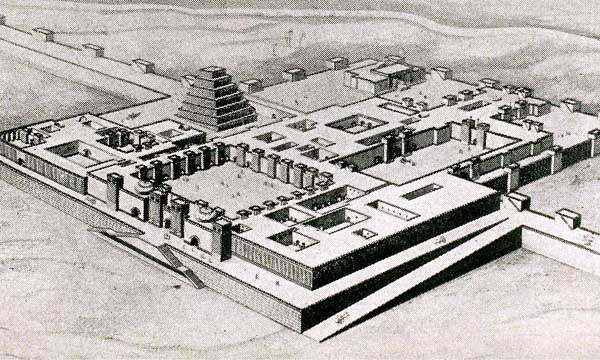
http://www.brynmawr.edu/Acads/Cities/wld/00130/00130a.jpg
Decipherment of Cuneiform
Development of writing: www.mesopotamia.co.uk/writing/story/sto_set.html
Gives us some access to the writing and thoughts of these people:
http://www.sumerian.org/proverbs.htm
Hammurabi
http://jade.ccccd.edu/Andrade/WorldLitI2332/Meso/hammarabi2.gif
Assyrians:
Known for:
Unbelievable sculptures, incredibly famous and highly valued.
http://jade.ccccd.edu/Andrade/WorldLitI2332/Meso/wingedguardian.gif
Empire! Warfare
Nimrud, Nineveh
Babylon
e.g. Ishtar Gate, Nebuchadnezzar
EGYPT
Ozymandias.... King of Kings...

1817: English poet Percy Bysshe Shelley publishes his sonnet “Ozymandias”
I met a traveller from an antique land
Who said: Two vast and trunkless legs of stone
Stand in the desert. Near them, on the sand,
Half sunk, a shattered visage lies, whose frown,
And wrinkled lip, and sneer of cold command
Tell that its sculptor well those passions read
Which yet survive, stamped on these lifeless things,
The hand that mocked them, and the heart that fed:
And on the pedestal these words appear: ‘My name is Ozymandias, king of kings: Look on my works, ye mighty, and dispair!”
Nothing besides remains. Round the decay
Of that colossal wreck, boundless and bare,
The lone and level sands stretch far away.”
Accurate? Nope. Evocative? Definitely. Revealing of the English perception of Egypt as a place of dead history, surpassed by modern civilization? Just Maybe : )
A few things about Egypt
PLACE

 Nile: 6,825 km long!
Nile: 6,825 km long!


(Museum of Fine Arts, Boston)
below: Nile inundation
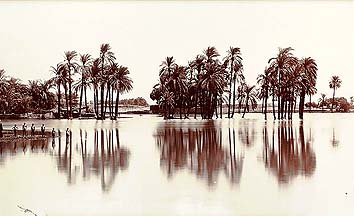
"
| This photo appears to have been taken during the time of the Nile's annual inundation. Rains in the highlands of Abysinnia swelled the Blue Nile, which met the White Nile at Khartoum and sent the rising, silt-laden waters north to cover the fields of Egypt. During the summer months Egypt disappeared beneath the brown waters, the whole of the land a vast sheet of water stretching from desert to desert, with the villages protruding like islands from the flood. In antiquity this was a time of increased navigation, festivals in honor of the inundation, booths and bowers on the edge of the swollen river, and festooned boats upon the waters. Since the building of the High Dam, the inundation no longer occurs in the Nile valley north of Aswan." |
"http://www-oi.uchicago.edu/OI/DEPT/PUB/CATALOG/LE2.2.html
ARCHAEOLOGY
Archaeological bonuses: burial rituals focused on deliberate preservation of bodies and burial goods; excellent natural preservation of sites because of hot, dry, sandy environment.
Other sources for information about the ancient Egyptians:
a) ancient historians, like Manetho, c. 300 BC, Egyptian historian and priest, whose works have not survived intact but are quoted in later historical works, e.g. by Jewish historian Josephus, first century AD.
b) ordinary documents
c) historical inscriptions on monuments themselves; pharaohs were constantly constructing their own histories, tracing lineages, recording their exploits, etc.
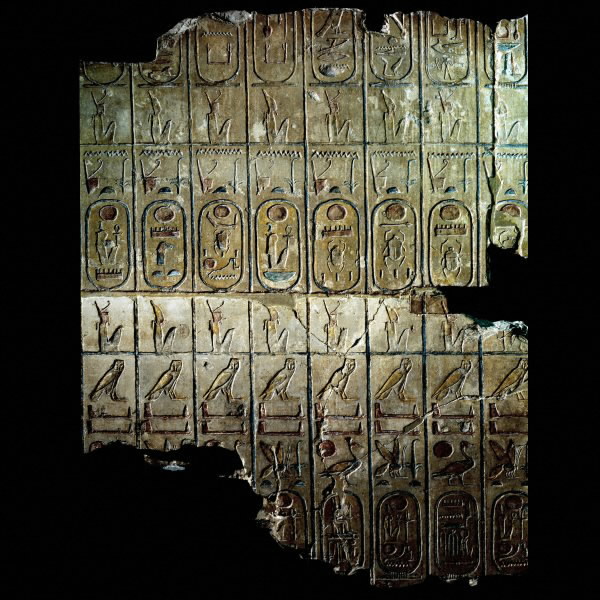
King List: 19th Dynasty, around 1250 BC, chronology of the rulers of Egypt so far, from a temple of Ramesses II.... but it is a selective list.
TIME
A good basic timeline: http://www.bbc.co.uk/history/ancient/egyptians/timeline.shtml
http://www.mfa.org/egypt/explore_ancient_egypt/learn_time.html
Predynastic Period: 5500 - 3100 BC.
0 Dynasty: Unification under Narmer and the Scorpion King.
First Dynasty 3050 - 2890 BC
Second Dynasty 2890 - 2686 BC
OLD KINGDOM: 2686 - 2181 BC. Centralised, unified government. Pharoah started to be divine.
Third Dynasty 2686 - 2613 BC: Djoser builds Step Pyramid at Saqqara.
Fourth Dynasty 2613 - 2498 BC: Khufu (Great Pyramid), Khafre (Sphinz, Second pyramid) and Menkaure build pyramids at Giza.
Fifth Dynasty 2498 - 2345 BC
Sixth Dynasty 2345 - 2181 BC
First Intermediate Period: 7th - 11th Dynasties 2181 - 2055 BC. A mess!
MIDDLE KINGDOM: 2055 - 1650 BC. Unified, prosperous, foreign trade, big building projects.
Mid-Eleventh Dynasty (Mentuhotep I) 2060 - 1991 BC
Twelfth Dynasty 1991 - 1782 BC
Thirteenth Dynasty 1782 - 1650 BC (first half only)
Second Intermediate period 1650 - 1570 BC. Periods of Hyksos rule.
New Kingdom: 1570 - 1070 BC. Again, centralized, unified government.
Eighteenth Dynasty 1570 - 1293 BC: a renaissance of art and building. Tuthmosis (multiple), Hapshetsut, Akhenaten, Tutankhamun
Nineteenth Dynasty 1293 - 1185 BC: Ramesses I, II, III, Seti I and II
Twentieth Dynasty 1185 - 1070 BC: Ramesses IV-XI. breakdown of government. Officials rob tombs and priests assume secular power.
Third Intermediate Period: 1070 - 664 BC. Includes periods of Libyan and Kushite rule.
Late Period: 664-332 BC: Includes periods of Persian rule.
Macedonian and Ptolemaic Period: 332 - 3O BC. Alexander the Great conquered Egypt in 332 BC, built Alexandria. His general Ptolemy I ultimately succeeded him -- and 14 more Ptolemies after that. Rosetta Stone. Cleopatra VII, daughter and co-regent of Ptolemy XII, and sister/co-regent of Ptolemy XIV, ruled Egypt at the end. (Romantic liaisons with Roman rulers Julius Caesar, Marc Anthony.... Rome declared war on Cleopatra/Egypt in 32 BC, and in 30 BC, Octavian, Julius Caesar's adopted son (later known as Roman Emperor Augustus), conquered Egypt and proclaimed himself Pharaoh. Egypt then part of the Roman Empire.
Roman rule: 30 BC - AD 395
Coptic Egypt: Christianity arrived in Egypt around 50AD with St. Mark, and a Christian community started in Alexandria. Eventually there were many (60?) Christian monasteries in Egypt and the religion was generally widespread. Difficulties came when the Romans under Diocletian started to suppress other religions, particularly Christianity. Much martyrdom for a period of about 30 years, 284-313 AD, until the Romans decided on a policy of tolerance again. Christianity continues in parts of Egypt to the present day.
Byzantine: AD 395-640 Ruled from Constantinople, predominantly Christian.
Islamic/Arab Period (Caliphate) Egypt: 640 AD onwards. Ruled from Damascus and from Baghdad.
Ottoman Period: AD 1517-1805. Ruled from Turkey.
Napoleon's expedition: circa 1800, short-lived.
Khedeval Period: AD 1805-1914
British Protectorate: AD 1914-1922
Monarchy: AD 1922-1953
Republic: AD 1953-
made it to here in class on Jan 31
Past in the Present
The Epic of Gilgamesh, from the people who built Ur, closes:
“Since the days of yore there has been no permanence;
The resting and the dead, how alike they are”
Touring Exhibitions:
Treasures from the Royal Tomb of Ur have been on the road.
http://mcclungmuseum.utk.edu/specex/ur/ur.htm
New discoveries about Ur... in Britain
Finding new things all the time, even from well-established finds that have been sitting in museums for the better part of a century. For example, the artifacts from the Death-Pit at Ur have been in the BM since the 1920s.... but only recently, Xrays of a "group of crushed skulls" (embedded in wax by Woolley for travel) showed two previously undiscovered head-dresses.
www.thebritishmuseum.ac.uk/science/whatsnew/ur.htm
Meanwhile, back in Iraq...
The situation for archaeological sites and artifact/antiquities in Iraq today is very bad.
- destruction during war - accidental and also deliberate damage, e.g. ziggurat of Ur
- widespread looting of sites
- dramatic looting of the Baghdad Museum (National Museum of Iraq) http://news.bbc.co.uk/2/hi/in_depth/photo_gallery/2947511.stm, http://edition.cnn.com/2003/WORLD/meast/04/15/sprj.irq.museum.looting/
in April 2003.
Many of the most famous artifacts from Mesopotamia -- e.g. Ur harp, Lady of Warka, Warka Vase, all seen in the video -- were missing and only recently recovered.
e.g. Lady of Warka
Missing since the Baghdad museum was looted. Recovered Sept 2003.
Interpol listing: http://www.interpol.int/public/WorkOfArt/Items/Data/1022/1022368.asp
Narrative: https://listhost.uchicago.edu/pipermail/iraqcrisis/2003-September/000376.html
News story: http://www.sfgate.com/cgi-bin/article.cgi?file=/c/a/2003/09/24/MN14606.DTL
US Lady of Warka listing: http://exchanges.state.gov/culprop/iraq/00000027.htm , US general Iraq listing: http://exchanges.state.gov/culprop/imimage.html
Lament of Ur
("the goddess of Ur, Ningal, tells how she suffered under her sense of coming
doom.")
When I was grieving for that day of storm, that day of storm, destined for me,
laid upon me, heavy with tears, that day of storm, destined for me, laid upon me
heavy with tears, on me, the queen.
Though I was trembling for that day of storm, that day of storm destined for me
--
I could not flee before that day's fatality.
And of a sudden I espied no happy days within my reign, no happy days within my
reign.
Though I would tremble for that night, that night of cruel weeping destined for
me, I could not flee before that night's fatality. Dread of the storm's
floodlike destruction weighed on me, and of a sudden on my couch at night, upon
my couch at night no dreams weregranted me. And of a sudden on my couch
oblivion, upon my couch oblivion was not granted.
Because (this) bitter anguish had been destined for my land -- as the cow to the
(mired) calf -- even had I come to help it on the ground, I could not have
pulled my people back out of the mire.
Because (this) bitter dolor had been destined for my city, even if I, birdlike,
had stretched my wings,
and, (like a bird), flown to my city, yet my city would have been destroyed on
its foundation, yet Ur would have perished where it lay.
Because that day of storm had raised its hand, and even had I screamed out loud
and cried; "Turn back, O day of storm, (turn) to (thy) desert," the breast of
that storm would not have been lifted from me.
Then verily, to the assembly, where the crowd had not yet risen, while the
Anunnaki, binding themselves (to uphold the decision), were still seated, I
dragged my feet and I stretched out my arms, truly I shed my tears in front of
An. Truly I myself mourned in front of Enlil:
"May my city not be destroyed!" I said indeed to them. "May Ur not be
destroyed!" I said indeed to them.
"And may its people not be killed!" I said indeed to them. But An never bent
towards those words,
and Enlil never with an, "It is pleasing, so be it!" did soothe my heart.
(Behold,) they gave instruction that the city be destroyed, (behold,) they gave
instruction that Ur be destroyed, and as its destiny decreed that its
inhabitants be killed.
Enlil called the storm. The people mourn. Winds of abundance he took from the
land. The people mourn. Bood winds he took away from Sumer. the people mourn.
Deputed evil winds. The people mourn. Entrusted them to Kingaluda, tender of
storms.
He called the storm that annihilates the land. The people mourn. He called
disastrous winds. The people mourn. Enlil -- choosing Gibil as his helper
--called the (great) hurricane of heaven. The people mourn. The (blinding)
hurricane howling across the skies -- the people mourn --
the tempest unsubduable like breaks through levees, beats down upon, devours the
city's ships,
(all these) he gathered at the base of heaven. The people mourn.
(Great) fires he lit that heralded the storm. The people mourn. And lit on
either flank of furious winds the searing heat of the desert. Like flaming heat
of noon this fire scorched.
The storm ordered by Enlil in hate, the storm which wears away the country,
covered Ur like a cloth, veiled it like a linen sheet.
On that day did the storm leave the city; that city was a ruin. O father Nanna,
that town was left a ruin. The people mourn. On that day did the storm leave the
country. The people mourn.
Its people('s corpses), not potsherds, littered the approaches. The walls were
gaping;
the high gates, the roads, were piled with dead. In the wide streets, where
feasting crowds (once) gathered, jumbled they lay. In all the streets and
roadways bodies lay. In open fields that used to fill with dancers, the people
lay in heaps.
The country's blood now filled its holes, like metal in a mold; bodies dissolved
-- like butter left in the sun.
(Nannar, god of the Moon and spouse of Ningal, appeals to his father, Enlil)
O my father who engendered me! What has my city done to you? Why have you turned
away from it?
O Enlil! What has my city done to you? Why have you turned away from it?
The ship of first fruits no longer brings first fruits to the engendering
father, no longer goes in to Enlil in Nippur with your bread and food portions!
......................................................
O my father who engendered me! Fold again into your arms my city from its
loneliness!
O Enlil! Fold again my Ur into your arms from its loneliness! Fold again my
(temple) Ekishnugal into your arms from its loneliness! Let renown emerge for
you in Ur! Let the people expand for you:
let the ways of Sumer, which have been destroyed, be restored for you!
Enlil answered his son Suen (saying):
"The heart of the wasted city is weeping, reeds (for flutes) of lament grow
therein, its heart is weeping, reeds (for flutes) of lament grow therein, its
people spend the day in weeping. O noble Nanna, be thou (concerned) about
yourself, what truck have you with tears?
There is no revoking a verdict, a decree of the assembly, a command of An and
Enlil is not known ever to have been changed. Ur was verily granted a kingship
-- a lasting term it was not granted.
From days of yore when the country was first settled, to where it has now
proceeded,
Who ever saw a term of office completed? Its kingship, its term of office, has
been uprooted. It must worry. (You) my Nanna, do you not worry! Leave your
city!"
Thorkild Jacobsen, The Treasures of Darkness: A History of Mesopotamian -
(borrowed from www.ur.com.jo/lemant.htm)
Amazing Ancient Texts (not required)
The Epic of Gilgamesh www.wsu.edu/~dee/MESO/GILG.HTM
The Code of Hammurabi www.wsu.edu/~dee/MESO/CODE.HTM
Notes on Cuneiform www.wsu.edu/~dee/GLOSSARY/CUNEI.HTM